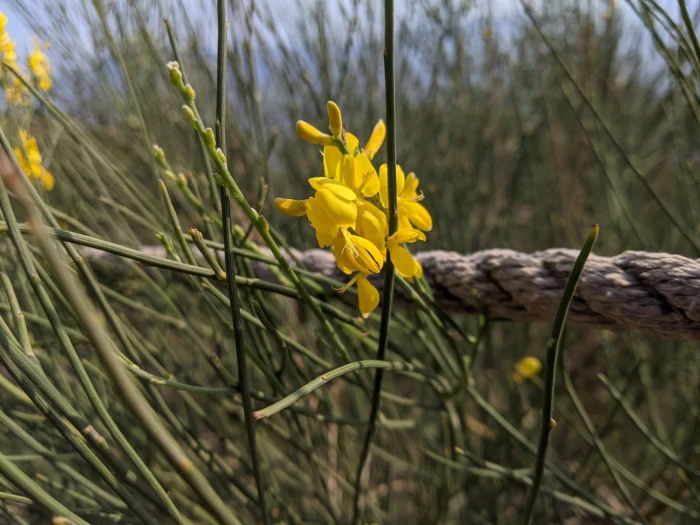Spanish Broom
(Spartium junceum)
Spanish Broom (Spartium junceum)
/
/

bemma
CC BY 4.0
Image By:
bemma
Recorded By:
Copyright:
CC BY 4.0
Copyright Notice:
Photo by: bemma | License Type: CC BY 4.0 | License URL: http://creativecommons.org/licenses/by/4.0/ | Rights Holder: bemma | Publisher: iNaturalist | Date Created: 2021-08-23T16:09:28-07:00 |




















































Estimated Native Range
Climate Requirements for Salinas, California
| This Plant | Your Site | Plant Suitability for Your Location | ||
|---|---|---|---|---|
| • Precipitation | 0" - 118" | 15" | Your precipitation may be insufficient for this plant. Irrigate N" / year. | Irrigate N" / year |
| • High Temp. | 49°F - 105°F | 77°F | Your summer temperatures are normal for this plant. | Excellent |
| • Low Temp. | 8°F - 70°F | 40°F | Your winter temperatures are normal for this plant | Excellent |
This plant should grow well at your location with about N inches per year (Y minutes per month) of irrigation.
Summary
Spartium junceum, commonly known as Spanish Broom, is a deciduous shrub native to the Mediterranean region, specifically thriving in dry, sunny sites such as coastal areas, garrigues, and rocky hillsides. It is a vigorous shrub that typically grows to 2–4 m (7–13 ft) tall, with main stems that can be up to 5 cm (2 in) thick. Spanish Broom has a distinctive appearance with its thick, rush-like grey-green shoots that perform most of the photosynthesis, an adaptation to its arid native habitat. The small, sparse leaves are 1 to 3 cm long and up to 4 mm broad, and they fall away early in the season. This shrub is particularly noted for its bright yellow, pea-like flowers that bloom in the summer and fall, providing a showy display that is highly valued in ornamental plantings.
Spanish Broom is appreciated for its drought tolerance and its ability to thrive in poor soils, making it a low-maintenance choice for gardeners. It is often used in xeriscaping, as a specimen plant, or for erosion control on slopes. The plant is also recognized for its fragrant flowers, which have earned it the Royal Horticultural Society’s Award of Garden Merit. While it prefers full sun, it can tolerate a range of soil types with varying drainage. However, gardeners should be cautious as it can become invasive in some regions outside its native range, and it is prone to root rot in overly wet conditions.CC BY-SA 4.0
Spanish Broom is appreciated for its drought tolerance and its ability to thrive in poor soils, making it a low-maintenance choice for gardeners. It is often used in xeriscaping, as a specimen plant, or for erosion control on slopes. The plant is also recognized for its fragrant flowers, which have earned it the Royal Horticultural Society’s Award of Garden Merit. While it prefers full sun, it can tolerate a range of soil types with varying drainage. However, gardeners should be cautious as it can become invasive in some regions outside its native range, and it is prone to root rot in overly wet conditions.CC BY-SA 4.0
Plant Description
- Plant Type: Shrub
- Height: 5-10 feet
- Width: 5-10 feet
- Growth Rate: Rapid
- Flower Color: Yellow
- Flowering Season: Summer, Fall
- Leaf Retention: Deciduous
Growth Requirements
- Sun: Full Sun
- Water: Low
- Drainage: Slow, Medium, Fast
Common Uses
Bank Stabilization, Border Plant, Drought Tolerant, Erosion Control, Fragrant, Rock Garden, Salt Tolerant, Showy Flowers
Natural Habitat
Thrives in dry, sunny sites such as coastal areas, garrigues, and rocky hillsides in the Mediterranean region
Other Names
Common Names: Weaver’s Broom, Rush Broom, Genet D’Espagne, Varenak, Kurdglis Tzotzkha, Spaanse Brem, Ispanski Drok, Metelnik Prutievidnyi, Broom Absolute, Genet Absolute
Scientific Names: Spartium junceum, Genista juncea, Spartianthus junceus, Spartium japonicum, Spartium acutifolium, Cytisus junceus, Galega ochroleuca, Genista acutifolia, Genista americana
GBIF Accepted Name: Spartium junceum L.